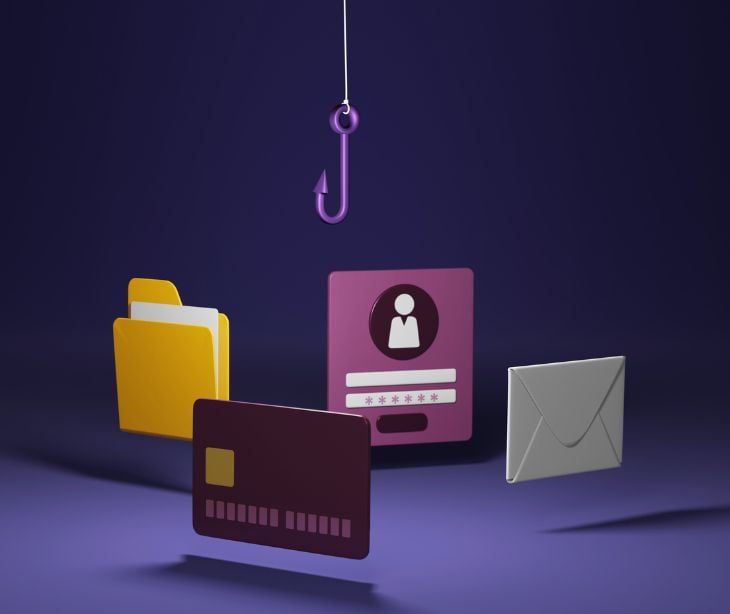
Smishing is a phishing attack that targets users through mobile text messaging, also known as SMS phishing. As a variant of phishing, victims are deceived into giving sensitive information to a disguised attacker. It occurs on many mobile text messaging platforms, including non-SMS channels like data-based mobile messaging apps.
Understanding smishing
Smishing, a combination of ‘SMS‘(short message services) and ‘phishing,’ is a social engineering attack that exploits human trust rather than technical exploits. Instead of sending fraudulent emails like traditional phishing attacks, smishing attackers use text messages to deceive victims into providing sensitive information.
Read more: What is social engineering and why healthcare is vulnerable
How smishing works
Scammers use different tactics to deceive victims into taking action. They pretend to be trusted entities, like organizations or people, to make their targets more likely to believe them. They often send personalized messages that trigger emotions and urgency, making it harder for victims to think critically.
The ultimate goal of a smishing attack is to get the recipient to open a URL link within the text message. This link leads to a phishing tool, which prompts the victim to disclose their private information. Attackers may also use malware or malicious websites to steal data, such as personal and financial information.
Go deeper:
Types of smishing attacks
Smishing attacks can take various forms, each with its unique premise. Here are some common types of smishing attacks to be aware of:
Financial services smishing
These attacks mimic notifications from financial institutions, banking services, or credit card companies. Victims may receive urgent requests to unlock their accounts, verify suspicious activity, or provide personal information.
Gift smishing
Attackers entice victims with promises of free services or products, often from reputable retailers or companies. These smishing messages may involve giveaway contests, shopping rewards, or exclusive offers.
Invoice or order confirmation smishing
Victims receive false confirmations of recent purchases or billing invoices for services they haven't used. Attackers may provide a link to a phishing tool, triggering fear of unwanted charges or enticing victims to click out of curiosity.
Customer support smishing
Attackers pose as support representatives from trusted companies. They claim an issue with the victim's account and provide instructions to resolve it. These instructions may involve fraudulent login pages or requests for account recovery codes.
How to protect yourself from smishing
While smishing attacks can be deceptive, there are several steps you can take to protect yourself from falling victim:
Do not respond
Avoid engaging with smishing messages, even if they prompt you to reply or unsubscribe. Responding may confirm your active phone number to attackers.
Slow down
Approach urgent messages cautiously, especially if they involve account updates or limited-time offers. Take the time to verify the legitimacy of the message through official channels.
Remain skeptical
Legitimate institutions do not request sensitive information or account updates via text messages. Avoid clicking on links or providing personal information unless you can verify the source independently.
Check the phone number
Be wary of unusual phone numbers, especially those with only four digits. Scammers may use email-to-text services or burner phones to hide their true identities.
Opt out of storing credit card numbers
Avoid saving credit card information on your phone's digital wallet. This reduces the risk of stolen financial information in case of a smishing attack.
Use multi-factor authentication
Enable multi-factor authentication (MFA) whenever possible, as it provides an additional layer of security. This can include text message verification codes or dedicated authentication apps.
Download anti-malware apps
Install reputable anti-malware apps on your mobile device to protect against malicious apps and smishing links. These apps can help identify and block potential threats.
Report smishing attempts
If you receive a smishing message, report it to the relevant authorities, such as your mobile service provider or the Federal Trade Commission (FTC). Reporting helps protect others from falling victim to the same scam.
What to do if you become a victim
If you believe you have fallen victim to a smishing attack, it's important to take immediate action to minimize the damage:
Report the attack
Notify the relevant institutions, such as your bank or credit card company, about the smishing attack. They can guide you through the necessary steps to protect your accounts and prevent further fraud.
Change passwords and PINs
Change all passwords and PINs associated with the compromised account. Use strong, unique passwords for each account.
Monitor your accounts
Regularly monitor your financial accounts, credit reports, and online activity for any suspicious transactions or unauthorized access. Promptly report any unusual activity to the respective institutions.
Subscribe to Paubox Weekly
Every Friday we'll bring you the most important news from Paubox. Our aim is to make you smarter, faster.




